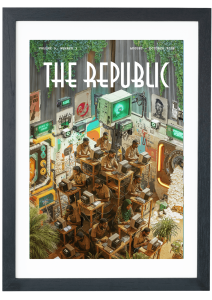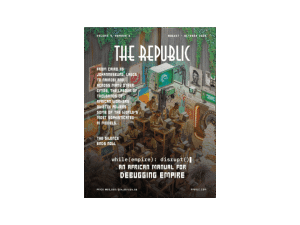
Photo Illustration by Ezinne Osueke / THE REPUBLIC. Source Ref: Ian Barbour / FLICKR, WorldRemit Comms / FLICKR.
THE MINISTRY OF BUSINESS X THE ECONOMY
Financial (Dis)Integration Within ECOWAS

Photo Illustration by Ezinne Osueke / THE REPUBLIC. Source Ref: Ian Barbour / FLICKR, WorldRemit Comms / FLICKR.
THE MINISTRY OF BUSINESS X THE ECONOMY
Financial (Dis)Integration Within ECOWAS
Financial integration is one of those rare economic ambitions that countries all agree on in principle but struggle to execute in practice. The idea is simple: remove barriers to capital flows, harmonize monetary policies, and create a seamless economic bloc. The benefits are obvious—lower transaction costs, increased intra-regional trade and enhanced macroeconomic stability. Yet, the track record of regional economic blocs achieving this is mixed at best.
Nowhere is this dichotomy clearer than in Africa, where two major economic communities—the Economic Community of West African States (ECOWAS) and the East African Community (EAC)—have pursued financial integration with starkly different outcomes. As ECOWAS marks its golden jubilee, it is necessary to reflect on its quest for not just economic integration but more specifically financial integration. ECOWAS has spent nearly 50 years debating a single currency now called the Eco with little to show for it. By contrast, the EAC, since its revival in 2000, has methodically integrated payment systems, harmonized regulations, and leveraged mobile money to create de facto financial unity—even without a formal currency union.
Why has one succeeded where the other flounders? The answer lies not in economics alone but in political cohesion, institutional pragmatism, the embrace of digital disruption, and, as we will see, the practical realities faced by those building the financial bridges.
THE ECOWAS PARADOX: GREAT AMBITIONS, WEAK EXECUTION
In the world of economics, as with many human endeavours, the allure of grand ambition is powerful. The vision of sovereign nations banding together, harmonizing policies and forging a unified economic bloc is undeniably attractive to reap the benefits of increased trade, macroeconomic stability, and collective self-sufficiency. ECOWAS, born from the 1975 Treaty of Lagos , embarked on such a journey, with financial and monetary integration as a cornerstone of its long-term aspirations—a journey now spanning five decades.
One cannot fault the original intent. ECOWAS’ founding treaties, from the original 1975 version to the revised 1993 edition, outlined a phased and ambitious path toward regional integration. This journey envisioned three distinct stages; establishing a common market, progressing to an economic union, and ultimately achieving a monetary union. Each phase built on the previous, reflecting a deliberate strategy of deepening cooperation over time.
The first milestone, the common market, aimed to go beyond removing tariffs and trade barriers. It envisioned a region where goods, services, labour, and capital could move freely across borders, effectively transforming West Africa into a single economic space. ECOWAS sought to achieve this by reducing internal trade frictions and promoting cross-border mobility particularly through its Protocol on the Free Movement of Persons.
The second phase of an economic union was meant to align national economic policies more closely. This involved harmonizing fiscal strategies, coordinating monetary frameworks and standardizing regulations across sectors such as finance, infrastructure and agriculture. The objective was to operate not merely as a trading bloc, but as an integrated economic entity.
The final and most complex stage, the monetary union, involved adopting a single currency or establishing fixed exchange rates under a shared central authority. For ECOWAS, this vision coalesced around the long-anticipated Eco currency. A successful monetary union was expected to enhance intra-regional trade and investment, strengthen policy credibility, foster resilience to external shocks, and create a deeper, more liquid financial market. Yet, this phase demanded a level of macroeconomic convergence and political commitment that has remained persistently out of reach.
UNDERSTANDING ECO’S ORIGINS
The Eco, initially envisioned as a unifying force for West Africa, has instead laid bare the region’s deep political and economic divisions. Announced in 1983 this single currency has been repeatedly delayed by shifting political priorities and uneven macroeconomic convergence. The project was revived in June 2019 when ECOWAS leaders agreed in Abuja on key principles: that the currency would be named the eco, it would be governed by a federal-style central bank, and operate under a flexible exchange rate regime with inflation targeting.
However, by February 2020, in a surprising turn, Ivorian President Alassane Ouattara alongside French President Emmanuel Macron unilaterally announced that the eight West African Economic and Monetary Union (UEMOA) countries, all users of the CFA franc, would adopt the Eco by 2020. This version of the Eco retained a fixed exchange rate pegged to the euro and continued French monetary guarantees, sidestepping the convergence criteria agreed upon in Abuja.
For Nigeria and other non-CFA states in the West African Monetary Zone, this move was not only diplomatically provocative but appeared to reassert French influence over a project meant to represent African economic sovereignty. It also suggested a realignment of power, with UEMOA attempting to reframe regional monetary integration around its own terms. While the Ivorian-led initiative claimed practical continuity and economic prudence, arguing that the peg to the euro supported trade and macroeconomic stability, Anglophone states criticized the lack of consultation and the abandonment of foundational ECOWAS principles.
Despite this setback, ECOWAS heads of state reaffirmed their commitment to the Eco in June 2021, and again in September 2023, setting a new target for launch by 2027. The revised timeline is now part of broader efforts to unify regional payment systems, attract foreign direct investment, and facilitate cross-border economic activity.
shop the republic
THE ELUSIVE ECO: SYMBOLISM MEETS STUBBORN REALITY
The Eco was envisioned as West Africa’s ‘euro moment’—a potent symbol of unity and emerging economic strength. Instead, it has arguably become more symbolic of the profound difficulties in aligning divergent sovereign interests. The litany of postponements tells its own story. The stated rationale for these deferrals often points to the failure of member states to meet macroeconomic convergence criteria, including inflation, exchange rates, fiscal deficits and the like.
Yet, as is so often the case, these technical hurdles frequently serve as a convenient screen for more deeply entrenched political and structural realities. One cannot ignore the gravitational pull of Nigeria, the region’s economic behemoth. In a 2019 report for the Brookings Institute, Aloysius Uche Ordu suggests that countries like The Gambia and Sierra Leone fear net losses in a currency union, as economic models suggest the benefits would disproportionately favour Nigeria and Côte d’Ivoire, while smaller economies will bear the brunt of adjustment costs. Smaller states, quite understandably, harbour concerns about ceding monetary sovereignty—particularly to a bloc where one member’s fiscal discipline (or lack thereof, as some perceive it from Nigeria’s history with inflation and exchange controls) could disproportionately impact all others. Trust, the most essential lubricant of all collective endeavours, seems to be in perennially short supply.
Then there is the matter of the CFA franc, still utilized by the Francophone bloc and backed by France. The CFA franc zone comprises 14 African countries divided into two regional monetary unions: UEMOA, which includes Benin, Burkina Faso, Côte d’Ivoire, Guinea-Bissau, Mali, Niger, Senegal and Togo; and the Economic and Monetary Community of Central Africa, comprising Cameroon, the Central African Republic, Chad, the Republic of the Congo, Equatorial Guinea and Gabon. These countries use either the West African CFA franc (XOF) or the Central African CFA franc (XAF), both of which are pegged to the euro at a fixed exchange rate, with monetary policy heavily influenced by the French treasury.
Historically, member countries were required to deposit a substantial portion of their foreign exchange reserves with the French treasury, a policy recently reformed for the West African bloc but remains in place for Central Africa. Critics have long viewed the CFA franc arrangement as a relic of neo-colonialism, arguing that it constrains the monetary sovereignty of member states and inhibits independent policy-making. The psychological and structural weight of this arrangement presents a significant obstacle to the development of a truly sovereign regional currency, such as the proposed eco. The continued reliance on the CFA franc by a majority of Francophone West African states not only entrenches economic dependency on France but also complicates the path to broader monetary integration within ECOWAS, as divergent currency regimes undermine the collective momentum needed for a unified economic future.
It is also worth noting, perhaps, that significant leaps in integration elsewhere have sometimes been catalyzed by crisis. ECOWAS, it seems—despite rifts in the bloc by the creation of the Alliance of Sahel States—has not yet faced a shock of sufficient magnitude to forge that kind of urgent, unifying consensus. The current 2027 target for the Eco, therefore, feels less like a firm commitment and more like another hopeful entry in a long-running diary of deferral.
THE PAYMENT SYSTEM QUAGMIRE
Beneath the aspirational facade of the Eco, lies a fragmented and outdated payment infrastructure that hinders meaningful progress toward West Africa’s financial integration. A significant impediment, as echoed by industry players like Africa’s Fintech Powerhouse, Flutterwave, is the lack of interoperability among national payment systems. For instance, Ghana’s Ghana Interbank Payment and Settlement Systems and Nigeria’s Nigeria Inter-Bank Settlement System operate independently and with limited coordination. This disjointedness results in cross-border payments that are slow, expensive and inefficient, impeding regional trade and economic cohesion.
Thus, Africa remains the most expensive regions for remittances, with a World Bank 2024 report revealing an average remittance fee of 8.4 per cent compared to the global average of 6.65 per cent. This places a particularly heavy burden on low-income users and small businesses.
Regulatory discrepancies, as industry players highlight, further exacerbate the situation. Divergent frameworks across ECOWAS member states—differences in Know Your Customer and Anti-Money Laundering requirements, licensing regimes, and data privacy laws—create administrative hurdles that discourage efficient transactions. These inconsistencies hinder the establishment of a cohesive regional financial ecosystem necessary for a successful monetary union. The absence of shared Application Programming Interface, messaging formats and authentication protocols prevents national systems from communicating effectively, while incompatible cross-border data transfer laws inhibit real-time transaction verification.
Moreover, while East Africa has embraced mobile money services—revolutionizing financial inclusion—West African nations have been slower in adopting digital financial solutions. The region remains heavily reliant on cash transactions and traditional banking systems. Industry players point to limited banking and payment infrastructure, particularly in rural areas, which reduces access to formal financial services and excludes many from cross-border commerce. Low levels of financial inclusion, with many individuals lacking IDs or formal accounts, makes user onboarding difficult. Additionally, currency volatility across multiple local currencies introduces complexity and risk. Even cultural factors, such as language diversity and lower levels of trust in digital systems, coupled with high service delivery costs tied to telecom dependency, can hinder financial inclusion and the scalability of digital financial products.
Initiatives like the Pan-African Payment and Settlement System (PAPSS) developed by Afreximbank aim to address these challenges by facilitating real-time cross-border payments across Africa in local currencies and reducing dependence on foreign currencies. Flutterwave views PAPSS as a critical step, enabling local currency settlements and enhancing financial inclusion. However, they rightly caution that wider adoption and deeper integration with existing national instant payment systems (IPS) are essential for its success. PAPSS currently includes only 15 of 54 African central banks, five of which are in ECOWAS—Nigeria, Ghana, Liberia, Senegal and Guinea. Less than half of these active IPS enable seamless interaction between banks and non-banks. The success of such top-down initiatives, it seems, depends heavily on resolving these underlying issues of fragmented regulation and securing genuine buy-in and adoption at the national level.
shop the republic
EAST AFRICA’S PLAYBOOK: THE M-PESA REVOLUTION
The most profound changes are rarely heralded by grand pronouncements. Instead, they often emerge quietly, addressing fundamental needs in innovative ways. The story of mobile money in East Africa, spearheaded by Kenya’s M-Pesa, offers a compelling illustration of this principle—especially when contrasted with West Africa’s ongoing journey toward monetary integration with the proposed Eco currency. It helps us reflect on what can be achieved from bottom-up innovation as opposed to top-down ambition.
M-Pesa was launched in Kenya in 2007 by Safaricom and Vodafone, initially as a tool for microfinance loan repayments. It quickly pivoted to enable person-to-person mobile money transfers, addressing a critical gap in financial access—at the time, only 26 per cent of Kenyans had bank accounts, but mobile phone use was widespread. Supported by a flexible regulatory environment and a rapidly growing agent network, M-Pesa expanded into savings, credit, and insurance services. By 2024, it dominated Kenya’s financial transactions with a 92.3 per cent market share, facilitating KES 8.7 trillion ($67 billion)—more than half the country’s GDP. M-Pesa did not just improve financial access; it redefined the infrastructure of Kenya’s economy.
Several factors underpin M-Pesa’s success, offering valuable lessons for driving transformative change. First, the initiative was private sector-led—Safaricom responded to clear market needs and a gap in formal financial access. Crucially, the government played a supportive role by creating an enabling regulatory environment. Through the Central Bank of Kenya’s test-and-learn approach, M-Pesa was allowed to operate under close supervision while risks were assessed. This flexible framework enabled innovation to thrive without the burden of premature or restrictive regulations. This highlights a recurring theme: the most effective solutions arise when entrepreneurial drive is coupled with an enabling, rather than overbearing government hand.
Secondly, the inherent scalability of mobile technology proved to be a game-changer. Unlike traditional banking infrastructure, which can be costly and slow to deploy, mobile money could reach even the most remote areas relatively quickly. This rapid adoption was particularly impactful in a region with historically limited access to formal financial services. It underscores the power of leveraging existing infrastructure, in this case, mobile networks, to overcome developmental hurdles.
The impact of this innovation did not stop at Kenya’s borders. Since 2008, through strategic partnerships, M-Pesa extended its reach into Tanzania, Uganda and Rwanda, enabling seamless cross-border mobile money transfers. This effectively created a de facto regional currency, facilitating trade and fostering greater financial inclusion across the East African Community. It is a powerful example of how practical, user-driven solutions can organically foster regional integration—often more swiftly than official policy frameworks.
THE EAST AFRICAN PAYMENT SYSTEM: A MASTERCLASS ON PRAGMATISM AND BALANCED POWER
Yet, M-Pesa was only one part of East Africa’s broader financial integration story. While mobile money captured headlines and users, institutional collaboration quietly advanced behind the scenes. The East African Payment System (EAPS) offers a compelling case study in pragmatic, incremental progress—one that complements the bottom-up success of mobile money with top-down infrastructure alignment.
EAPS. did not wait for the elusive single currency or the grand financial unification we so often hear about. Instead, it focused on the art of the possible, ingeniously linking the existing real-time gross settlement systems of Kenya (KEPSS), Tanzania (TISS), Uganda (UNISS), and Rwanda (RIPPS). The brilliance lies in its simplicity: connecting what already exists to facilitate real-time, low-cost interbank transfers without the prerequisite of a unified currency. It is the financial equivalent of building bridges between islands rather than attempting to create a new landmass from scratch.
The EAPS is not without its challenges as it is experiencing low uptake due to a lack of interoperability, communication gaps, fear of scams, and protectionism by central banks. However, signs of renewed commitment are emerging. In 2025, the members of the EAC member states adopted the Draft EAC Cross-Border Payment System Masterplan, a step that signals collective will to strengthen and scale the platform.
A key ingredient in EAPS’s relative success has been the balanced distribution of influence among member states of the East African Community Kenya functions as the financial hub, Tanzania brings market size, and Rwanda contributes policy innovation. This equilibrium fosters mutual respect and discourages domination, creating space for collaborative policymaking and shared ownership of integration initiatives.
shop the republic
-
‘The Empire Hacks Back’ by Olalekan Jeyifous by Olalekan Jeyifous
₦70,000.00 – ₦75,000.00Price range: ₦70,000.00 through ₦75,000.00 This product has multiple variants. The options may be chosen on the product page -
‘Make the World Burn Again’ by Edel Rodriguez by Edel Rodriguez
₦70,000.00 – ₦75,000.00Price range: ₦70,000.00 through ₦75,000.00 This product has multiple variants. The options may be chosen on the product page -
‘Nigerian Theatre’ Print by Shalom Ojo
₦150,000.00 -
‘Natural Synthesis’ Print by Diana Ejaita
₦70,000.00 – ₦75,000.00Price range: ₦70,000.00 through ₦75,000.00 This product has multiple variants. The options may be chosen on the product page
shop the republic
THE WAY FORWARD FOR ECOWAS
ECOWAS’ pursuit of a unified regional currency symbolizes its long-standing ambition for deeper economic integration. Yet, persistent infrastructural and regulatory disparities among member states suggest that, while this goal is laudable, it may be premature. The repeated delays, most recently with a revised target of 2027, highlight unresolved challenges, ranging from divergent fiscal and monetary policies to uneven economic structures. As ECOWAS reflects on 50 years of regional cooperation, a more grounded approach seems both necessary and wise.
Rather than pursuing the symbolic big bang of a single currency, ECOWAS might better serve its member states by focusing on the foundational elements if regional integration. This includes leveraging existing initiatives like the African Continental Free Trade Area and the Pan-African Payment and Settlement System to boost intra-regional trade. These initiatives would be further strengthened by the adoption of open standards such as ISO 20022 for financial messaging. By providing a common language and model for financial transactions ISO 20022 facilitates consistent and rich data exchange across different financial institutions and systems, improving payment processing efficiency and reducing errors.
Moreover, adopting ISO 20022 can support private sector innovations by providing a standardized framework that simplifies integration across different regulatory environments. Companies like Flutterwave exemplify how private sector innovation can help stitch together fragmented regulatory regimes—provided there is greater harmonization and collaboration between policymakers and innovators.
Nigeria’s economic dominance, within ECOWAS has also raised valid concerns around fiscal discipline and macroeconomic volatility. This imbalance reinforces the case for flexible integration models: allowing more ready states like Ghana, Côte d’Ivoire, and Senegal to move forward in a ‘coalition of the willing,’ while others catch up at their own pace.
The East African Community offers a compelling contrast. Its progress has not been driven by sweeping declarations but by steady, incremental steps—mobile money rollouts, payment system upgrades, and quiet regulatory reforms. This tortoise-like path, grounded in practical, cumulative progress, may ultimately present West Africa with the most sustainable route to integration.
As ECOWAS steps into its next era, the real opportunity may not lie in chasing a moonshot, but in compounding small wins: building interoperable systems, harmonizing regulations, and fostering trust through consistent collaboration⎈
BUY THE MAGAZINE AND/OR THE COVER
-
‘Make the World Burn Again’ by Edel Rodriguez by Edel Rodriguez
₦70,000.00 – ₦75,000.00Price range: ₦70,000.00 through ₦75,000.00 This product has multiple variants. The options may be chosen on the product page -
The Republic V9, N2 Who Dey Fear Donald Trump? / Africa In The Era Of Multipolarity
₦40,000.00
















